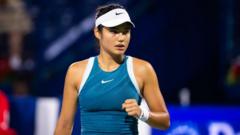Should McLaren Have Let Norris Overtake Piastri?

George Russell's Triumph and the Intrigue of McLaren's Driver Dynamics at the Canadian Grand Prix
The Canadian Grand Prix witnessed an electrifying race that culminated in George Russell capturing Mercedes' first victory of the season. However, the day's drama was primarily dominated by the actions of McLaren drivers Lando Norris and Oscar Piastri. Their collision, stemming from a misjudged maneuver by Norris, raised questions not only about their racing tactics but also about the team's strategy moving forward. As rookie Kimi Antonelli celebrated his first Formula 1 podium, the implications of team dynamics and driver performance lingered in the air, prompting discussions among fans and analysts alike.
The Collision: A Closer Look at Norris and Piastri
The collision between Norris and Piastri is emblematic of the fierce competition within the McLaren team. As Norris attempted to pass his teammate, he miscalculated the available space, leading to a crash that forced both drivers to retire from the race. This incident has sparked debates among fans and pundits regarding whether McLaren should have issued team orders to prioritize one driver over the other.
Understanding McLaren's Driver Philosophy
McLaren has maintained a clear philosophy regarding their driver dynamics: they allow their drivers to race each other. Team Principal Andrea Stella has articulated that the only scenario in which team orders might be employed is when one driver is in contention for the championship while the other is not. This philosophy underlines McLaren's commitment to fostering an environment where both drivers can compete freely, which is essential for their development and for the team's overall success.
Implications of Team Orders
In the context of the Canadian Grand Prix, the idea of issuing team orders raises several questions. Would prioritizing Norris, given his experience, have resulted in a better outcome for the team? Or would it have undermined the competitive spirit that McLaren aims to cultivate? With both drivers currently in contention for the championship, enforcing team orders could potentially lead to friction and undermine the team's ethos.
Performance Comparison: Norris vs. Piastri
Oscar Piastri's performance this season has sparked comparisons with his more experienced teammate, Lando Norris. While some fans argue that Piastri is significantly outperforming Norris, the reality is more nuanced. Both drivers have shown flashes of brilliance, yet Piastri has been more consistent in delivering strong results without the errors that have plagued Norris.
Analyzing the Statistics
- Consistency: Piastri has been able to capitalize on Norris's mistakes, securing points even when the latter has had stronger weekends.
- Qualifying Performance: Norris's struggles in qualifying have hindered his race outcomes. In races like Saudi Arabia and Miami, his errors during qualifying have cost him valuable positions on the grid.
- Head-to-Head Stats: While Piastri has taken the lead in their head-to-head matchups, the margins have often been slim, indicating that both drivers are capable of delivering strong performances.
The Psychological Aspect of Competition
One cannot ignore the psychological pressures that both drivers face. Norris, as a seasoned competitor, may feel the weight of expectations, particularly as this season presents one of his best opportunities for a championship. Meanwhile, Piastri, a rookie, is likely aware that he has an opportunity to establish himself as a top-tier driver in the sport. Balancing these pressures is crucial for both drivers to find their rhythm and avoid costly mistakes.
Max Verstappen: A Persistent Threat
In the midst of McLaren's internal battles, Max Verstappen remains a formidable presence on the grid. Finishing second in Canada, he has demonstrated his ability to capitalize on the chaos created by others. Despite not being in the fastest car, Verstappen's consistency and racecraft make him a constant threat as the season progresses.
The Challenge of Competing Against McLaren
Verstappen's journey this season has been marked by both triumphs and challenges. While he has shown remarkable skill in navigating difficult situations, he must contend with the reality of driving a car that is not consistently the fastest. The points gap between him and the McLaren duo is significant, and every race presents an opportunity for him to close that gap.
Red Bull's Protest: A Closer Examination
The protests lodged by Red Bull against George Russell have sparked discussions about the ethics of racing and the limits of competitive tactics. In Canada, Red Bull's protest centered around Russell's behavior behind the safety car, claiming he had engaged in unsportsmanlike conduct. This incident highlights the fine line teams walk in pushing the boundaries of the rules.
The Role of Protests in F1
- Competitive Strategy: Teams use protests as a means to gain a competitive edge, leveraging the rules to their advantage.
- Accountability: Protests ensure that drivers and teams are held accountable for their actions on the track, promoting fair competition.
- Impact on Team Relations: Frequent protests can strain relationships between teams and create an atmosphere of tension, but they are also a part of the sport's competitive nature.
Looking Ahead: The Future of McLaren and F1
The future of McLaren's ambitions in Formula 1 hinges on how they manage their two talented drivers. As the championship progresses, the balance between allowing free competition and ensuring team success will be tested. The lessons learned from the Canadian Grand Prix will undoubtedly shape their approach in the upcoming races.
Environmental Considerations in F1
As Formula 1 continues to evolve, it is also making strides towards sustainability. The decision to group the Montreal and Miami races next year aims to reduce carbon emissions, showcasing the sport's commitment to environmental responsibility. While logistical challenges remain, such initiatives represent a positive step towards a greener future for racing.
Conclusion: Navigating the Complexities of Formula 1
The Canadian Grand Prix has brought to light the intricate dynamics of driver competition, team strategy, and the overarching influence of regulations within Formula 1. As George Russell basks in his victory, the focus shifts to McLaren's internal rivalry and the challenges posed by seasoned competitors like Max Verstappen. The journey ahead promises to be filled with excitement, tension, and the relentless pursuit of excellence.
As we reflect on the lessons from Montreal, one question remains: how will McLaren navigate the complexities of driver dynamics as the championship battle intensifies? #F1 #CanadianGP #McLaren
FAQs
Why did McLaren allow their drivers to race each other during the Canadian Grand Prix?
McLaren's philosophy is to foster a competitive environment where both drivers can race freely, unless one driver is in contention for the championship while the other is not.
What caused the collision between Lando Norris and Oscar Piastri?
The collision resulted from Lando Norris misjudging the gap while attempting to pass Oscar Piastri, leading to a crash that ended both their races.
How does Max Verstappen's performance compare to that of McLaren drivers?
Despite not driving the fastest car, Verstappen has consistently performed well, finishing second in Canada and remaining a key contender in the championship, although he trails behind both McLaren drivers in points.
Published: 2025-06-17 12:08:06 | Category: sport



